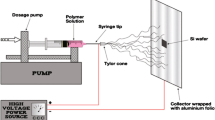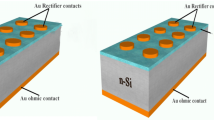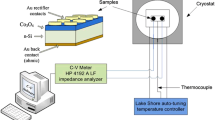Abstract
The main point of this article is to examine in detail the effects of interface/surface states (Nss), series resistance (Rs) and (Ni-doped PVA) polymer interlayer on current–voltage (I–V) and frequency dependent capacitance–voltage (C–V) properties at room temperature. Some main diode parameters such as reverse-saturation current (Is), ideality factor (n), barrier height (BH) (= ΦB(I–V)), Rs, and rectification ratio (RR = IF/IR) at ± 3 V were calculated from the linear part of LnI–V plot as 2.14 × 10−9 A, 1.606, 0.750 eV, 30.5 Ω, and 106, respectively. Energy dependent values of Nss were also extracted from the I–V data by considering voltage dependent ΒΗ and n they decrease from mid-gap of Si towards the bottom of valance band (Ev) almost as exponentially. The doping atoms (Na), Fermi energy level (EF), (ΦB(C–V)), and depletion layer width (WD) were also calculated from the reverse bias C−2–V curves as function of frequency. The achievement of obtained results that manufactured (Ni-PVA) interlayer provide better performance in respect of lower values of leakage current, Nss, Rs, and higher values of RR and shunt resistance. The dielectric value of (Ni-PVA) interlayer was found as 1.44 from the interlayer capacitance (Ci = ε′εoA/di) even at 20 kHz and this is higher than the dielectric value of SiO2 at 20 kHz. However, this value can be increased by increasing a dopant level of Ni until 5–7%. Therefore, this interlayer can be successfully use an alternative interface layer compared to traditional oxide interlayers.










Similar content being viewed by others
References
B.L. Sharma, Metal-semiconductor Schottky Barrier Junctions and Their Applications (Plenum Press, New York, 1984)
H. Tecimer, A. Türüt, H. Uslu, Ş. Altındal, İ. Uslu, Sens. Actuators A 199, 194 (2013)
J. Werner, H. Guttler, J. Appl. Phys. 69, 1522–1533 (1991)
S.M. Sze, Physics of Semiconductor Devices (Wiley, New York, 1981)
E. Özavcı, S. Demirezen, U. Aydemir, S. Altındal, Sens. Actuators A 194, 259 (2013)
Ş. Altındal, J. Mater. Electron Dev. 1, 42 (2015)
R.T. Tung, J.P. Sullivan, F. Schrey, Mater. Sci. Eng. B 14, 266 (1992)
W. Mönch, J. Vac. Sci. Technol. B 17, 1867 (1997)
E.H. Nicollian, J.R. Brews, Mos (Metal Oxide Semiconductor) Physics and Technology (Wiley, New York, 1982)
S. Demirezen, A. Kaya, Ö. Vural, Altindal. Mater. Sci. Semicond. Process. 33, 140–148 (2015)
S. Altındal Yerişkin, M. Balbaşı, İ. Orak, J. Mater. Sci. 28, 14040–14048 (2017)
M. Sharma, S.K. Tripathi, Appl. Phys. A 113, 491–499 (2013)
C. Tozlu, A. Mutlu, Synth. Met. 211, 99–106 (2016)
V.R. Reddy, Thin Solid Films 556, 300–306 (2014)
M.S.P. Reddy, H.-S. Kang, J.-H. Lee, V.R. Reddy, J.-S. Jang, J. Appl. Polym. Sci. 131, 131 (2014). https://doi.org/10.1002/app.39773
S. Boughdachi, Y. Badali, Y. Azizian-Kalandaragh, Ş. Altindal, J. Electron. Mater. 47, 6945–6953 (2018)
E.A. Akhlaghi, Y. Badali, Ş. Altindal, Y. Azizian-Kalandaragh, Phys. B 546, 93–98 (2018)
Y. Badali, A. Nikravan, Ş. Altindal, İ. Uslu, J. Electron. Mater. 47, 3510–3520 (2018)
Serhat Orkun Tan, J. Polytech. 21(4), 977–989 (2018)
S.O. Tan, IEEE Trans. Electron Devices 64, 5121–5127 (2017)
S. Alialy, Ş. Altındal, E.E. Tanrıkulu, D.E. Yıldız, J. Appl. Phys. 116, 083709 (2014)
P.S. Ho, E.S. Yang, H.L. Evans, X. Wu, Phys. Rev. Lett. 60, 177 (1986)
X. Wu, E.S. Yang, J. Appl. Phys. 65, 3560 (1989)
P. Chattopadhyay, B. Raychaudhuri, Solid State Electron. 35, 875 (1992)
Ç. Bilkan, A. Gümüş, Ş. Altındal, Mat Sci Semicond Process 39, 484 (2015)
B. Bati, C. Nuhoğlu, M. Sağlam, E. Ayyildiz, A. Türüt, Phys. Scrıpta 61, 209 (2000)
J. Werner, A.F.J. Levi, R.T. Tung, M. Anzlowar, M. Pinto, Phys. Rev. Lett. 60, 53 (1988)
H.C. Card, E.H. Rhoderick, J. Phys. D 4, 1589 (1971)
S. Alialy, A. Kaya, E. Marıl, S. Altındal, I. Uslu, Phil. Mag. 95, 1448 (2015)
S. Altındal Yerişkin, J Mater Sci: Mater Electron 30, 17032 (2019)
İ. Taşçıoğlu, S.O. Tan, F. Yakuphanoğlu, Ş. Altındal, J. Electron. Mater. 47, 6059–6066 (2018)
S. Altındal Yerişkin, M. Balbaşı, S. Demirezen, Indian J. Phys. 91, 421–430 (2017)
V. Rajagopal Reddy, V. Manjunath, V. Janardhanah, Y.-H. Kıl, C.-J. Choı, J. Electron. Mater. (2014). https://doi.org/10.1007/s11664-014-3177-3
Y.S. Ocak, M. Kulakcı, T. Kılıcoğlu, R. Turan, K. Akkılıc, Synth. Met. 159, 1603 (2009)
V.R. Reddy, V. Janardhanah, J.-W. Ju, H.-J. Yun, C.-J. Choi, Solid State Commun. 179, 34 (2014)
H. Norde, J. Appl. Phys. 50, 5052 (1979)
S.K. Cheung, N.W. Cheung, Appl. Phys. Lett. 49, 85 (1986)
A.A.M. Farag, A. Ashery, E.M.A. Ahmed, M.A. Salem, J. Alloys Compd. 495, 116 (2010)
Acknowledgements
This work is supported by Amasya University BAP research Project with FMB-BAP 17-0292 number. The author wishes to express his gratitude to Prof. Dr. Şemsettin Altındal for his abundantly helpful support and guidance.
Author information
Authors and Affiliations
Corresponding author
Additional information
Publisher's Note
Springer Nature remains neutral with regard to jurisdictional claims in published maps and institutional affiliations.
Rights and permissions
About this article
Cite this article
Demirezen, S. The role of interface traps, series resistance and (Ni-doped PVA) interlayer effects on electrical characteristics in Al/p-Si (MS) structures. J Mater Sci: Mater Electron 30, 19854–19861 (2019). https://doi.org/10.1007/s10854-019-02352-3
Received:
Accepted:
Published:
Issue Date:
DOI: https://doi.org/10.1007/s10854-019-02352-3




